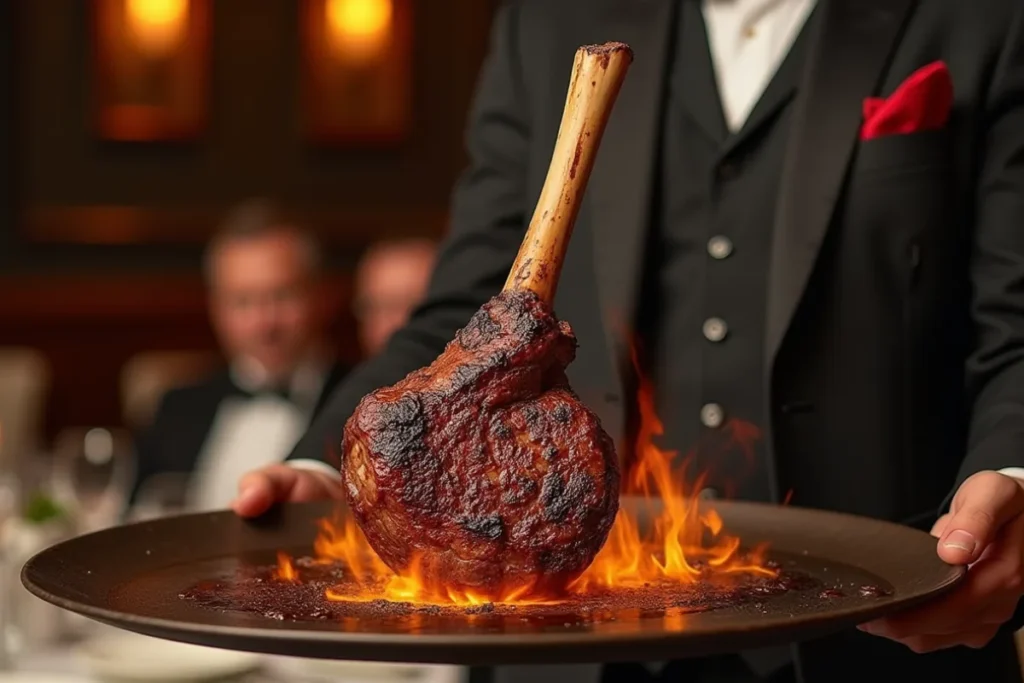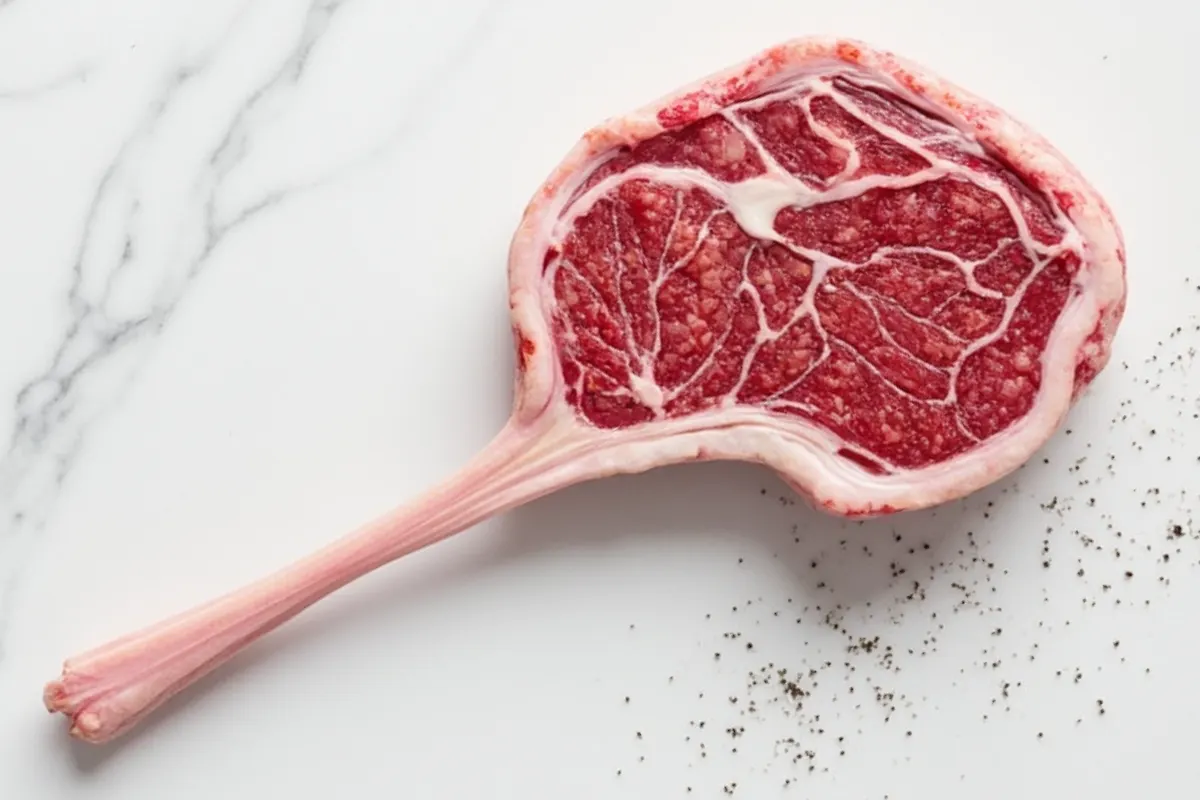Introduction: The Allure of the Tomahawk Steak
Picture this: you’re sitting at your favorite steakhouse. The server brings out a massive steak. It’s a tomahawk, and it looks almost too good to eat. The long bone juts out dramatically, making the steak a visual masterpiece. But when the bill arrives, you may be shocked by the price. You might ask yourself, why are tomahawk steaks so expensive?
Is the cost just because of its size, or is there more behind this hefty price tag? In this article, we will explore the reasons for the high cost of tomahawk steaks. We’ll discuss the factors, including sourcing, preparation, and even the overall dining experience, that contribute to its price. By the end, you’ll know exactly why the tomahawk steak is worth every penny—or why you may want to consider alternatives.
Understanding the Tomahawk Steak
What is a Tomahawk Steak?
A tomahawk steak is a bone-in ribeye with a long, Frenched bone. The bone is cleaned and exposed, giving the steak its characteristic tomahawk shape. This unique presentation adds a dramatic visual appeal that sets the tomahawk apart from other cuts.
The tomahawk steak comes from the rib section of the cow. It’s a large cut, often weighing 30 ounces or more, making it a substantial meal. The ribeye is well-known for its marbling, or the fat interspersed throughout the muscle. This marbling gives the meat its tenderness and flavor. When the bone is left intact, it enhances the taste by contributing extra flavor during the cooking process.
The size and appearance of the tomahawk steak make it a favorite for those looking for something extraordinary. It’s not just about the beef—it’s about the whole experience of eating it.
The Anatomy of a Tomahawk Steak
The tomahawk steak comes from the rib section of the cow, specifically from the primal rib area. It’s a large, eye-catching cut that typically weighs between 30 to 45 ounces. The ribeye, from which the tomahawk is cut, has a reputation for its rich marbling. This marbling makes the meat tender, juicy, and flavorful. The bone adds a layer of complexity by imparting additional flavor during cooking.
The dramatic appearance of the tomahawk steak is not just for show. It’s a purposeful addition that enhances the overall eating experience. When you cook this steak, the bone contributes to both the flavor and the tenderness, resulting in a steak that’s truly a cut above the rest.
The Sourcing of Tomahawk Steaks
Premium Beef Breeds and Their Influence on Price
One major reason for the high price of tomahawk steaks lies in the breed of cattle used. Not all beef is created equal, and the breed plays a big role in the quality and cost of the meat. Two of the most common breeds used for high-end tomahawk steaks are Angus and Wagyu.
- Angus Beef: Angus cattle are known for their well-marbled meat. The fat content contributes to the meat’s tenderness and flavor. Angus cattle are typically grass-fed or grain-finished, and the beef from these cows is tender, flavorful, and widely recognized as a premium product. Certified Angus Beef, which meets strict standards, usually costs more than non-certified Angus cuts.
- Wagyu Beef: Wagyu beef, often considered the best in the world, comes from a special breed of cattle raised in Japan. The beef is famous for its rich marbling, which makes it incredibly tender and flavorful. Wagyu cattle receive careful attention to their diet and environment, which drives up the price of the beef. A tomahawk steak cut from Wagyu beef can cost several times more than one from Angus cattle.
The cattle’s feeding practices also impact the beef’s cost. Grass-fed beef is leaner, while grain-fed beef is typically fattier, making it more tender and flavorful. Grain-fed cattle generally result in more expensive tomahawk steaks.
Grass-fed vs. Grain-fed Cattle
Grass-fed cattle produce leaner beef with a more earthy flavor. Many people consider grass-fed beef to be a healthier option, but it’s not as tender as grain-fed beef. Grain-fed cattle, particularly those finished with corn, tend to produce more marbled meat, which makes the beef richer, juicier, and more tender. Because grain-fed beef has higher fat content, it typically costs more, especially for premium cuts like tomahawk steaks.
The Aging Process: Dry-Aged vs. Wet-Aged
Dry Aging: The Luxury Factor
The aging process is a crucial factor in determining the price of tomahawk steaks. Dry aging is the most expensive method. It involves hanging beef in a controlled environment for weeks, allowing natural enzymes to break down the muscle fibers. This process improves the steak’s tenderness and enhances its flavor. Dry aging also concentrates the flavors, giving the meat a nutty, richer taste.
Dry-aged beef requires careful storage. The temperature and humidity levels must be carefully controlled to ensure the steak ages properly. Additionally, dry-aging results in moisture loss, reducing the weight of the steak. As a result, dry-aged tomahawk steaks carry a higher price tag due to both the time involved and the weight loss.
Wet Aging: A Cost-Effective Alternative?
Wet aging is quicker and cheaper than dry aging. In this process, beef is vacuum-sealed and aged in its own juices for several weeks. While wet aging improves tenderness, it doesn’t develop the same deep flavors that dry aging does. As a result, wet-aged tomahawk steaks are usually less expensive than dry-aged ones.
The Role of Presentation and Marketing

The “Wow” Factor: Why Tomahawk Steaks Are Showstoppers
When you order a tomahawk steak, you’re not just buying a piece of meat. You’re buying an experience. The long bone of the steak makes it a showstopper. When a server brings the steak to your table, the size and appearance alone are enough to turn heads. The tomahawk steak commands attention and adds an element of theater to your dining experience.
At high-end restaurants, the steak is often served sizzling, which adds to the drama. This “wow” factor plays a large role in why restaurants can charge a premium for tomahawk steaks.
The Luxury Dining Experience
Tomahawk steaks are often associated with fine dining and celebrations. They’re the perfect choice for people looking to indulge in something special. When you eat a tomahawk steak, you’re paying not just for the beef but for the overall experience. From the ambiance of the restaurant to the service, everything adds up to make the dining experience feel luxurious.
Supply and Demand: Why Are They So Rare?
Limited Production and Specialty Cuts
The rarity of tomahawk steaks contributes to their high price. A single cow only yields a limited number of tomahawk steaks. As demand for these cuts rises, the price increases. Since tomahawk steaks are considered a specialty item, their production remains low, which maintains their exclusivity.
The limited supply and the high demand make tomahawk steaks a luxury item. As a result, producers keep their production levels controlled, further driving up the price.
The Cost of Cutting and Preparation
Cutting and preparing tomahawk steaks require skill. Butchers must carefully French the bone, exposing it without damaging the meat. This labor-intensive process requires precision and expertise. The cost of preparation, along with the time and care involved, contributes to the higher price.
Cooking Tomahawk Steaks: More Than Just a Steak
Grilling vs. Pan-Searing: The Art of Cooking
Cooking a tomahawk steak is an art form. Given its size, this cut requires careful attention to ensure it cooks properly. Grilling is the most popular method, as it allows the fat to render and adds a smoky flavor to the meat.
You can also pan-sear the steak and finish it in the oven. Both methods require precise timing to achieve a perfect balance of seared crust and tender interior. Cooking methods like these add to the cost, as they require more effort and skill.
Sous-vide or Reverse Searing: The Premium Methods
For those who want a perfect steak, sous-vide and reverse searing are top choices. Both methods ensure the steak is cooked evenly and to the exact temperature you prefer. Sous-vide involves cooking the steak in a water bath at a precise temperature, while reverse searing cooks the steak slowly before finishing with a high-heat sear. Both methods require patience and skill, which increase the overall cost of cooking.
Tomahawk Steaks at Home vs. Restaurants
Purchasing Tomahawk Steaks: What to Expect
If you want to cook a tomahawk steak at home, prices will vary depending on where you purchase it. Butcher shops and online meat suppliers often sell tomahawk steaks, but the cost may vary. You’ll pay for both the quality of the meat and the labor involved in its preparation.
How Restaurants Mark Up Tomahawk Steaks
Restaurants mark up tomahawk steaks significantly. The price includes not just the cost of the beef but also the overhead of running the restaurant. Labor, preparation, and luxury service contribute to the high markup.
Tomahawk Steaks and Their Cultural Appeal
The Steak of Choice for Special Occasions
Tomahawk steaks are often reserved for special occasions. When you order a tomahawk, you’re making a statement and marking a memorable moment.
Tomahawk Steaks in Popular Culture
In recent years, tomahawk steaks have gained cultural significance through food shows, celebrity chefs, and social media influencers. Their association with luxury has made them a symbol of indulgence and status. Tomahawk steaks are no longer just about food—they’ve become a part of popular culture.
Conclusion: Why You’re Paying More for Tomahawk Steaks
Tomahawk steaks are expensive for several reasons. From the breed of cattle to the aging process and the careful preparation, each factor contributes to the final price. When you order a tomahawk steak, you’re paying for more than just the meat—you’re paying for the entire experience. Whether you’re celebrating a special occasion or treating yourself, the tomahawk steak offers a unique dining experience.
FAQ: Why Are Tomahawk Steaks So Expensive?
- What is a tomahawk steak?
A tomahawk steak is a bone-in ribeye with a long, Frenched bone. The bone enhances the flavor and makes it visually striking. - Why do tomahawk steaks cost so much?
The high price comes from factors like the breed of cattle, the aging process, and the labor involved in preparing the cut. - Is it worth the price?
Many steak enthusiasts believe the tomahawk steak is worth the price because of its flavor, tenderness, and overall experience. - Are tomahawk steaks only available in restaurants?
No, you can purchase tomahawk steaks from specialty butcher shops and online meat suppliers, though they may be more expensive. - What’s the difference between a tomahawk steak and a ribeye?
A tomahawk steak is a ribeye with the bone left in, which adds to the flavor and presentation. - How should you cook a tomahawk steak?
Grilling, pan-searing, or sous-vide cooking are all great methods for preparing tomahawk steaks. The key is to cook it carefully to preserve its tenderness and flavor.

